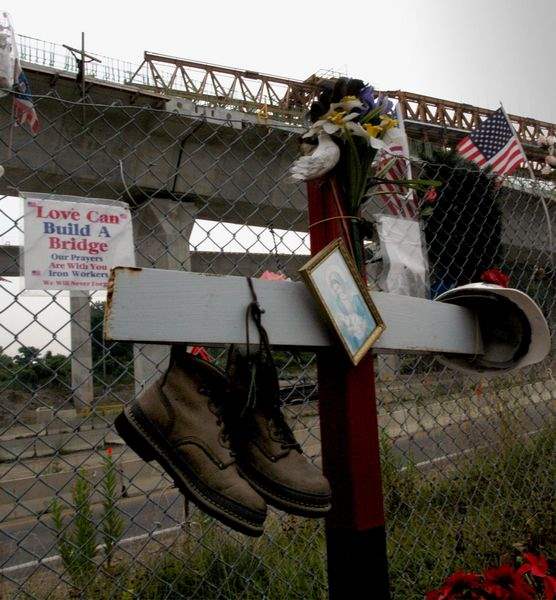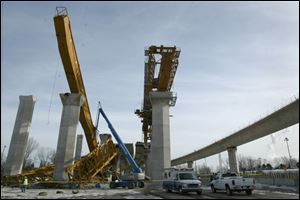
Once-model bridge project had cracks behind scenes
8/1/2004
A pair of sturdy work shoes, a hard hat, and a small print of the Madonna and Child complement a makeshift cross erected at the site to remember the workers killed and those injured.
long / blade

A pair of sturdy work shoes, a hard hat, and a small print of the Madonna and Child complement a makeshift cross erected at the site to remember the workers killed and those injured.
Weathered American flags flap in the humid, midsummer breeze - anchoring a makeshift memorial of crosses, flowers, and faded posters that stands in the shadows of what was once considered a model construction project.
Just six months ago, the new I-280 span over the Maumee River was more than a year ahead of schedule, logged few workers injuries, and drew praise from local and state officials for its ingenuity.
Showcasing the project were two star pieces of equipment: a pair of 315-foot cranes specially designed for the project and imported from Europe. They crawled in tandem to build the approaching deck to a cable-stayed bridge that would redraw the city's skyline.
But one of the cranes wouldn't finish the job.
On a frigid February afternoon, the 900-ton crane known simply as "LG2" slipped off its supporting piers and crashed 60 feet into a construction median, killing four ironworkers. On Friday, federal regulators would blame the collapse at least partially on grave mistakes by the project's general contractor.
The accident immediately halted work on the main approaching decks, led to a flurry of investigations, and exposed behind-the-scenes tensions in the biggest transportation construction project in state history.
The U.S. Occupational Safety and Health Administration on Friday proposed the largest fine possible against the general contractor, Fru-Con Construction Corp., claiming the company knew it was violating safety regulations when it failed to properly secure the crane.
Prosecutors are now reviewing the case for possible criminal charges while lawyers for the families of the dead and injured are continuing their own probes to prepare for an expected flurry of lawsuits that could take years to conclude.
The other crane - LG1 - remains perched above the hum of I-280 traffic, waiting for the day it can safely restart a key part of the project that now may not be finished until 2007.
Near that crane, families and friends of the four dead still trek to the make-shift memorial along a fence that abuts the Front Street on-ramp.
And the injured, such as Mark Buck, try to heal.
The 47-year-old operating engineer must still use a cane or crutches while his right foot heals from the tragedy that has kept him off work.
"I think about it everyday," he said.
In the words of an ODOT inspector, it was a "tirade."
Near a ramp pier one Wednesday in January, the obscenities flew between two inspectors over whether a cement segment would hold - and more.

After the accident, the collapsed crane, left, is on the ground as its twin remains in place, right.
In front of other workers, the pair engaged in a heated exchange about how one never consulted with the other, and how one never got out of his truck to inspect. It ended only when one of the inspectors stormed off in his Jeep.
It was one of the many tense moments that would not be mentioned in the press conferences touting a project with ambitious aims.
Nearly two years earlier, Fru-Con's upstart heavy civil group had landed its first contract, a complicated bridge that was set to break a world record for the largest cable stay, at 156 individual strands.
And the nation's fifth-oldest construction firm planned to complete the project 18 months ahead of schedule, by April, 2005. ODOT proudly gave public tours of the work site, impressing dignitaries with how smooth the operation ran.
But behind the scenes, there were personality disputes and questions over the details of building such a unique span, according to inspectors' logs obtained by The Blade.
Freezing temperatures, ice, and high winds complicated schedules. Cement cracked. Epoxy - a thick, sticky industrial glue that was to be slathered onto the cement sections - fell and globbed onto the roadway.
Tensions flared between union and management, between field supervisors and inspectors, and bewteen field workers and ODOT's inspectors and bridge consultants - and between Fru-Con's top managers.
In one incident, a Fru-Con manager accused an ODOT inspector of "playing God" when ODOT docked the company $288,000 for not following quality-control guidelines. The ODOT inspector fired back, writing in his log: "I told him we are not here to baby-sit him [and] that we have told him enough times, and it shouldn't be happening anymore."
And there was the heated exchange Jan. 21 between ODOT's own inspectors, one a full-time employee of the agency and the other an inspector for HNTB, the consulting firm hired by ODOT to help it oversee the project.
When asked about the tense exchanges, ODOT spokesman Joe Rutherford said they are typical on such big projects.
"That is nothing different that you see on any other project," he said.
In what could be a tense work environment came two new pieces of machinery specially made for the project by an Italian firm, Paolo de Nicola.
The erection cranes, known as launching gantries, would rest on bridge piers, take precast pieces of concrete, move them into place on the bridge's approach spans, and then crawl ahead to the next set of piers.
They were similar to a smaller gantry that had been in use for months to build the on-ramps, only the newest twin cranes were twice as big.
Just like on the smaller crane, ironworkers from Local 55 would be tapped to anchor the complicated big cranes in place during each move - on equipment they'd never operated before.
"Truthfully, this is an exotic animal," said Joe Blaze, Local 55's business manager. "This is not a normal rig that the ironworkers are used to dealing with. They've never seen anything like this."
Along the way, Fru-Con modified how they anchored the crane - using fewer high-tension bolts than originally recommended, OSHA would later conclude.
Fru-Con last week insisted that Paolo de Nicola had given its blessing to the modifications. But the Italian firm's attorney countered that the firm had voiced concerns over construction procedures before Feb. 16.
Regardless, Mr. Blaze said, ironworkers were left to do "what they were told."
And beyond the learning curve, the new cranes meant a loss of control.
Longtime ironworker James Savoy said he's used to sitting on a structure as a crane delivers material up to him. But with the erection cranes, the equipment is overhead.
"The difference here is we usually control what we're doing," said Mr. Savoy, a foreman on the smaller erection crane. "In this job, everything is over top of you. If something happens, there's no way out."
Ossi Wolter heard the wrenching steel before he saw it.
A superintendent on the smaller crane for bridge ramps, Mr. Wolter was giving instructions to his crew about 2:22 p.m. Monday when the sound of hundreds of tons of falling steel stopped all work.
He stared helplessly. At the skyline, where the two hulking cranes had been moving almost in tandem moments earlier from the bridge's 11th set of spans, only one remained.
Its sister, LG2, which had been working on the bridge's northbound lanes, lay in an ugly, twisted heap below. Worse, on the bridge's pier lay the bodies of two ironworkers. Another had been caught by his safety harness. A fourth worker, fatally wounded, lay on the ground.
Four others were injured.
"It's 900 tons. I can do nothing. Nobody can do anything," said the 56-year-old German bridge builder whose work has taken him as far away as Nigeria, Thailand, and Iraq. "I've never seen anything like it."
One ODOT worker later reported seeing "the rear leg of LG2 bouncing on the pier table" as he ran from the scene with a second worker, who looked back to see "the rear of the truss falling off of [the pier] over his head."
The collapse killed four: Arden Clark, 47, Robert Lipinski, Jr., 44, Mike Moreau, 30, and Mike Phillips, 42. Two ironworkers and two operating engineers were injured.
Hours after the accident, the remaining crane was reversed and locked into position, where it has remained since.
Work continued on other parts of the project, including building the ramps with the smaller gantry, but the accident cast a pall over the project that has since endured other problems.
In March, OSHA inspectors cited Fru-Con for inadequately protecting employees on scaffolding and those below, proposing a $23,000 fine.
In April, crews had to remove 184 cubic yards of concrete from the bridge's central pylon because it wasn't strong enough.
In the meantime, Fru-Con and ODOT are preparing plans to use LG1, although there's still debate over what happened to its doomed twin.
OSHA on Friday blamed Fru-Con for "willful" violations and proposed a $280,000 fine.
"It is our belief that had this been properly anchored per the manufacturer's specifications, the likelihood of collapse would have been significantly diminished," said Jule Jones, head of the Toledo OSHA office.
Still, OSHA's findings may offer only a partial picture of what happened. The full report won't be released until its case is settled with Fru-Con. And the state won't release its findings about the crash, saying they could be used as part of a lawsuit.
ODOT Assistant Director Richard Martinko wouldn't "speculate" Friday on what happened, insisting that OSHA's findings may not be the ultimate cause.
Fru-Con's project manager, Dave Herron, agreed.
While he said the company has "commissioned the best experts we can find in the country" to find ways to improve the remaining crane, he insisted the company still didn't know why the first one collapsed.
"We can't speculate," he said. "What we've done is gone through the whole system and reviewed the whole design and implemented all the changes we believe are necessary."
Mark Buck, still hobbled by injuries to his right foot, can't play ball with his young son.
An operating engineer, he was working in a conventional crane below LG2 when LG2 came crashing down.
Like other victims and their families, he doesn't want to talk about what happened Feb. 16, or what he thinks of OSHA's findings. But he said he thinks about the tragedy everyday while he waits for the doctors to be more specific about his future.
He's had one surgery and might have more.
As he waits, collecting workman's compensation payments equal to about 70 percent of his salary, the 47-year-old Swanton man is bored, although he tries to have a healthy attitude.
"I'm healing slowly but surely. They told me it'd be a long, drawn-out deal that takes time," he said. "I miss just being able to get out and walk."
For those who didn't survive, friends and family erected a memorial along the fenceline between Ravine Park II and I-280.
Loved ones have left flowers, poems, scriptures, sayings, pictures, and boots. A girlfriend of one wrote how she's struggled to stop crying.
"What happened to our happily ever after?" she wrote. "It's so hard to make sense of it all because I don't understand. Maybe one day I will find my peace."
Blade staff writers Christopher D. Kirkpatrick and Mike Wilkinson contributed to this report.
Contact Joe Mahr at: jmahr@theblade.com or 419-724-6180.